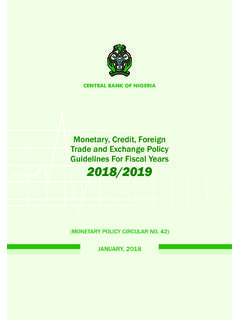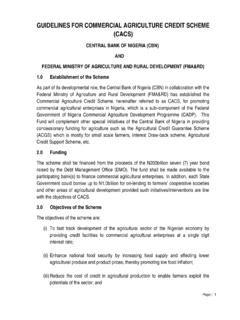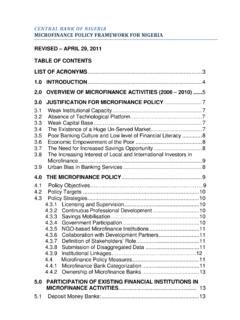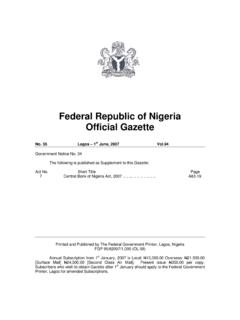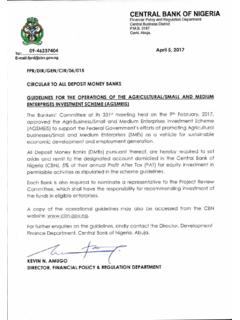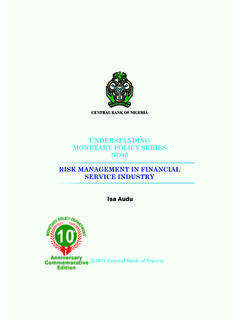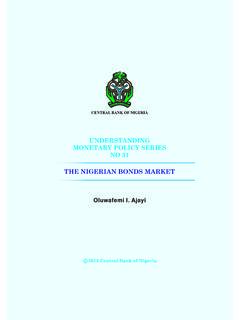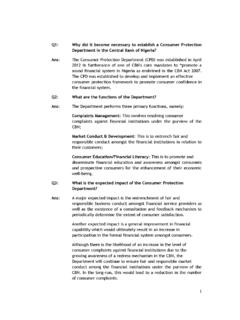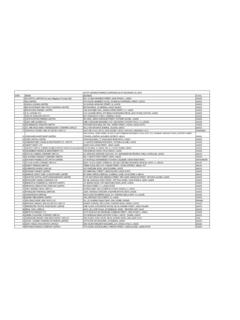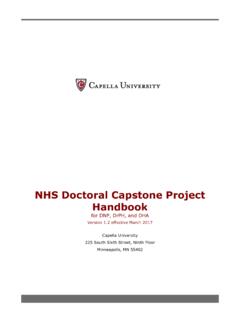Transcription of CENTRAL BANK OF NIGERIA
1 CENTRAL bank OF NIGERIA PRUDENTIAL GUIDELINES FOR DEPOSIT MONEY BANKS IN NIGERIA EFFECTIVE: 1 JULY 2010 2 CONTENTS Introduction 6 Definitions 8 Risk Management 11 Credit policy duly approved by board of directors 11 Limit on exposure to a single obligor/ connected lending 11 Credit concentration policies 11 Exposures to directors and their related interests 12 Disclosure of insider-related credits in financial statement 13 Bankers Acceptances and Commercial Papers 13 Basic Information on Borrowers 13 Minimum information on credit print-outs 14 Minimum contents of credit files 14
2 Margin lending 14 Revaluation of fixed assets 15 Foreign Exchange Risk - Net Open Position (NOP) Limit 15 Liquidity ratios 15 Statutory reserve 16 Cash reserve ratio 16 Capital adequacy ratio 17 Credit rating of counter party/ obligor 19 Credit rating of banks 19 Reconciliation of inter-branch accounts and settlement of suspense account entries: 19 Foreign borrowing for on-lending by Nigerian banks 19 Policies and procedures for write-off of fully provided credit facilities 20 Misreporting 20 Transitional Provisions 20 Corporate Governance 21 Tenure of Non Executive Directors 21 Tenure of External Auditors 21 Know Your Customer and Anti-money laundering 22 Know your customer 22 Anti-money laundering measures 22 Record retention 22 Correspondent banking 22 Suspicious transactions 23 Project Financing 24 Policy duly approved by
3 Board of Directors 24 Credit appraisal of projects 24 Assessment of projects 24 Monitoring of project 26 Maximum duration of loan 26 Moratorium 26 Object finance, Real estate and Commercial Real Estate 27 Policy duly approved by Board of Directors 27 Purpose of loan 27 Monitoring of real estate market 27 Duration of loan 27 Small and Medium Enterprises Financing 28 Policy duly approved by Board of Directors 28 Source, capacity of repayment and cash flow based lending 28 Securities 28 Agriculture Financing 29 Policy duly approved by Board of Directors 29 Repayment capacity of the borrower 29 Natural Calamities 29 Insurance of Agriculture produce 29 Proper utilization of loans 29 Valuation of Security 29 Cash flow based facilities 29 Microfinance loans 30 Retail financing 31 Minimum conditions for retail financing 31 Loan Loss Provisioning 32 Credit portfolio classification system for facilities
4 Other than Specialized loans 32 Provision for non-performing facilities other than Specialized loans as defined by the guidelines 34 Provision for non-performing facilities under Specialized loans 35 Adapting Prudential Guidelines to IFRS 35 Credit portfolio disclosure requirement 35 Disclosure requirement for Specialized loans 36 Interest accrual 36 Classification of other assets 36 Revolving and overdraft facilities 38 Facilities without approval 38 Off balance sheet engagements 38 Provisioning requirement for Specialized loans 39 Collateral adjustment and provisioning for lost facilities 40 Regulators power over adequacy of provisioning 42 Update of loan loss provisioning guidelines 43 Dynamic provisioning 43 Financial soundness indicators and financial ratios 44 5 Annexure 1 45 Annexure 2 47 Annexure 3 48 Annexure 4 49 Annexure 5 50 Annexure 6 52 Annexure 7 53 Annexure 8 57 Annexure 9 60 Annexure 10 64 Glossary 66 6 1 INTRODUCTION.
5 Background: The Nigerian banking sector witnessed dramatic growth post consolidation (2005) and the developments posed a lot of challenges for the industry and regulation. The initial perceptions that the Nigerian banking system was sound and insulated from global financial crisis were misplaced. The factors that led to creation of extremely fragile financial system that was tipped into crisis by the global financial meltdown include: 1. Macro-economic instability caused by large and sudden capital outflows; 2.
6 Major failures in corporate governance at banks; 3. Lack of investor and consumer sophistication; 4. Inadequate disclosure and transparency about financial position of banks; 5. Critical gaps in prudential guidelines (current prudential guidelines was issued in 1990) and 6. Uneven supervision and enforcement In addressing the above listed challenges, the CBN introduced a Four (4) Pillar Reform Programme in 2010 tailored towards: Enhancing the quality of banks; Establishing financial stability; Enabling healthy financial sector evolution; and Ensuring the financial sector contributes to the real economy As part of the initiative to enhance the quality of the banks, the CBN undertook a review of the prudential guidelines.
7 In this regard, the revised Prudential Guidelines aim to address various aspects of banks operations, such as risk management, corporate governance, KYC and anti-money laundering/ counter financing of terrorism and loan loss provisioning. The guidelines also aim to address the peculiarities of different loan types and financing to different sectors. Loan Loss Provisioning Guidelines: The loan loss provisioning guidelines which form part of the enhanced Prudential Guidelines provide guidance on recognition and measurement of loans, establishment of loan loss allowances, credit risk disclosure and related matters.
8 It sets out CBN s views on sound loan provisioning and disclosure practices for deposit money banks in NIGERIA . The guidelines also serve as a basic framework for evaluation of banks provisioning policies and practices. The objectives of the enhanced provisioning guidelines are to: 71) Promote enhanced provisioning policies and practices, which are consistent with sound risk management practices for Nigerian Banks; 2) Ensure that provisioning guidelines support the life cycle and gestation periods of the various specialized loans; 3) Provide a framework for ensuring that the current provisioning guidelines are counter-cyclical; and 4) Provide framework for Haircuts adjustments for LOST Facilities.
9 These prudential guidelines should be regarded as minimum requirements and licensed banks are encouraged to implement more stringent policies and practices to enhance mitigation of risks. SAMUEL A. ONI DIRECTOR OF BANKING SUPERVISION 8 DEFINITIONS (a) Commodities Finance refers to structured short-term lending to finance inventories or receivables of exchange-traded commodities ( crude oil, metals, crops or farm produce), where the exposure will be repaid from the proceeds of the sale of the commodity and the borrower has no independent capacity to repay the exposure.
10 (b) Retail financing means any financing allowed to individuals for meeting their personal, family or household needs. The facilities categorized as retail financing are as follows: (i) Credit Cards mean cards which allow a customer to make payments on credit. Supplementary credit cards shall be considered part of the principal borrower for the purposes of these guidelines. (ii) Auto Loans mean the loans to purchase the vehicle for personal use. (iii) Housing Finance means loan provided to individuals for the purchase of residential house / apartment / land.
